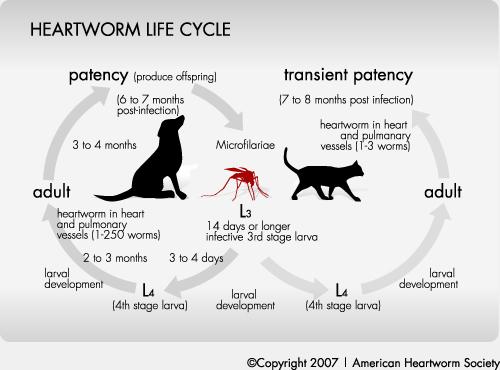
Heartworms are a serious problem. These parasitic worms live in the arteries of the lungs and the heart as adults, and can be fatal. Dogs and cats of any age and of any breed are susceptible. Heartworms can be found in all of the 50 United States.
How does my pet get heartworms?
First, adult female heartworms release their young, called microfilariae, into the bloodstream of an already infected animal. When a mosquito bites into the animal, it becomes infected with microfilariae. During the next 10 to 14 days, the microfilariae mature to the infective larval stage within the mosquito. At this point, the larvae are ready to move to a new animal. The mosquito bites another dog, cat or other susceptible animal, and the infecting larvae enter through the bite wound. It then takes a little over 6 months for the larvae to mature into adult worms. In dogs, the worms may live for up to 7 years. Microfilariae cannot mature into adult heartworms without first passing through a mosquito.
What signs are there that my pet has heartworm disease?
The early stages of heartworm may be difficult to detect in both dogs and cats, as the number of heartworms in an animal tends to grow gradually.
There may be no signs of the disease in a newly infected dog. A heavily infected dog may eventually show clinical signs, including a mild, persistent cough, reluctance to move or exercise, fatigue after only moderate exercise, reduced appetite and weight loss.
Cats may exhibit signs that are very non-specific, imitating many other feline diseases. Chronic clinical signs include vomiting, gagging, difficulty or rapid breathing, lethargy and weight loss. Signs associated with the first stage of heartworm disease, when the heartworms enter a blood vessel and are carried to the pulmonary arteries, are often mistaken for feline asthma or allergic bronchitis, when in fact they are actually due to a syndrome newly defined as Heartworm Associated Respiratory Disease (HARD).
Heartworm can be detected with blood screening for heartworm antigens and microfilariae. Blood tests are not consistently positive until about seven months after the initial infection. Adult heartworm infection may be detected through an ultrasound or x-ray of the heart and lungs, although these tests are usually used in animals already known to be infected.
How can I treat or prevent heartworm disease?
Cats do not have any products approved for the treatment of heartworm. Cats can be more resistant and sometimes rid themselves of infection spontaneously, though they may react poorly to the dead worms as they are being cleared from the body.
In dogs, heartworm can be treated with a drug called an adulticide. The drug is given as a series of injections that kill the adult heartworms.
Prevention is the best! There are a number of heartworm preventative products available for both dogs and cats. These products will kill microfilariae before they ever have a chance to infect your pet and do serious damage.
